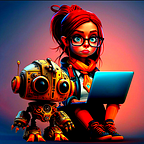2024’s UX Vanguard: 9 Cutting-Edge Trends Shaping the User Experience
👩💻 Navigating the UX Landscape of 2024: Trends and Transformations
Stepping into the new year, UX designers anticipate the latest design trends with eager anticipation. As technology evolves relentlessly, innovation reshapes the design realm, promising groundbreaking solutions. However, amidst the advancements, challenges emerge — balancing functionality, user needs, business objectives, and aesthetics. To overcome these hurdles, designers eagerly embrace emerging trends, reshaping digital experiences.
✔ Hyper-Personalization: Integrating AI and Machine Learning
At the forefront of evolution lies hyper-personalization, fueled by AI and machine learning integration. By understanding user preferences, designers craft intuitive interfaces tailored to deliver deeply personalized experiences, aligning products with individual user expectations.
📚 Top 9 UX Trends for 2024
Here are the top 9 UX trends for 2024 that enhance the overall user experience:
1. Glassmorphism
Glassmorphism, a design trend characterized by frosted glass effects, brings a modern and elegant aesthetic to digital interfaces. By incorporating translucent elements like cards, navigation panels, and modals, Glassmorphism adds depth and sophistication to designs. This trend continues to be popular in 2024, offering a visually appealing way to enhance user interfaces.
2. Generative Design
Generative design, powered by artificial intelligence and algorithms, revolutionizes the way designers create user interfaces. By leveraging AI, designers can generate layouts, color schemes, and typography that are both visually appealing and functional. This trend allows for more creativity and innovation in design, leading to dynamic and engaging user experiences.
3. Augmented Reality
Augmented reality (AR) continues to be a prominent trend in 2024, blurring the lines between the physical and digital worlds. By integrating AR elements into products, designers can create immersive and interactive experiences. From enhancing product visualization to transforming educational content, AR offers endless possibilities for creating unique and engaging user experiences.
4. Emotional design
Emotional design focuses on creating products that resonate with users on an emotional level. By considering users’ emotions, designers can create more meaningful and engaging experiences. This trend involves understanding users’ needs and preferences, and designing interfaces that evoke positive emotions. By incorporating elements like color psychology and empathetic design, designers can create experiences that leave a lasting impression on users.
5. Parallax Effect
The Parallax Effect is a visual technique that adds depth and dimension to websites. By moving background images at a different speed than the foreground, designers can create a sense of depth and immersion. This effect is particularly effective in storytelling, as it can guide users through a narrative in a dynamic and engaging way. In 2024, designers are finding new and creative ways to use the Parallax Effect to enhance user experiences.
6. Brutalism
Brutalism in web design embraces simplicity and rawness, challenging traditional design aesthetics. Characterized by bold typography, harsh grids, and limited color palettes, Brutalism prioritizes functionality over ornamentation. This trend continues to gain popularity in 2024, as designers seek to create bold and impactful designs that stand out from the crowd.
7. Hyperrealism
Hyperrealism in user interface design focuses on creating interfaces that closely resemble real-world objects and environments. By using photorealistic rendering and 3D modeling, designers can create interfaces that feel lifelike and immersive. This trend is particularly effective in industries like e-commerce and gaming, where realistic visuals can enhance the user experience.
8. Inclusive Design
Inclusive design aims to create products and interfaces that are accessible to people of all backgrounds and abilities. By considering a wide range of user personas, designers can create experiences that are easy to use and understand for everyone. This trend involves designing with empathy and inclusivity, ensuring that no user is left behind.
9. Green UX
Green UX focuses on designing sustainable and eco-friendly digital experiences. By minimizing visual clutter and using eco-friendly colors and themes, designers can reduce the environmental impact of their designs. This trend aligns with the growing focus on sustainability and environmental consciousness, offering designers a way to create impactful designs that are also environmentally friendly.
⚙️ Embracing Change: Designing for Tomorrow
In a landscape of constant evolution, designers must adapt to emerging trends to create impactful digital experiences. By staying attuned to user needs and technological advancements, designers navigate the evolving landscape with creativity and innovation, shaping the future of UX/UI design.
If you found this article helpful, attractive, useful and would like to support me, make sure to:
— — — — — — — — — — — — — — — — — — — — — — — — — — — — — — — — —
Authored by: [Niamh]
This collaborative research-driven exploration required [1] day of dedication and [2 to 3] hours of meticulous crafting.
Let’s get connected on Twitter: [@niamh_dcreator]
Thank you for your interest.
— — — — — — — — — — — — — — — — — — — — — — — — — — — — — — — — —
